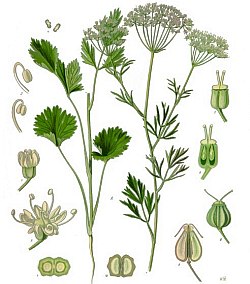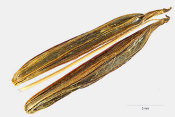Anise Characteristics
(Pimpinella Anisum, Linn.)

Name Origin:
Dates back to Ancient Greece and Rome and is mentioned in the Bible (Matthew xxiii, 23). Read more on the History of Anise.
Natural Order:
Umbelliferæ
Growing Cycle:
Annual Herb
Origins:
Southwestern Asia, northern Africa and south-eastern Europe. Later introduced throughout the Mediterranean region, Germany and other temperate regions.
Height:
18 – 36 inches tall
Appearance:
Root leaves lobed – similar to celery
Flowers:
Small yellowish-white flowers in large, loose umbels consisting of many umbellets.
Growing Anise
(Seeds, sowing, transplantation and harvesting)
Growing Anise From Seeds
When growing anise from seeds, it’s best to use seeds that are less than two years old.

Sow seeds where the plants will reside as soon as the weather becomes settled in early spring. Plant anise 1/2 deep and 1/2 apart in drills 15 or 18 inches apart. Anise thrives best in well-drained, light, rich, somewhat dry loamy soils well exposed to the sun. Plants require little care; keep weed free and a light application of well-rotted manure are all that is required.
Don’t miss our Anise Companion Planting Guide to explore companion planting with anise.
Transplantation
Not recommended as anise has a fairly long taproot.
Harvesting Anise
When your anise is around 4 months old (about a month before the flowers will bloom), the plants should be cut for drying. Or allow the plants to go through their entire growing cycle to harvest the seeds.
Culinary Uses of Anise
(leaves, seeds, and aniseseed oil)
Anise, with a similar flavor to fennel and tarragon and liquorice, is a strong flavor that has been used since the fourteenth century.
Leaves
Use as a garnish for flavoring salads.
Anise Seeds
Anise seeds are used to flavor curry powders, cake, pastry, confectionery, and some kinds of cheeses and breads. The seeds can be ground and compounded with other fragrant material to create sachet powders.
Anise Seed Oil
Anise oil is commonly used to flavor both alcoholic and non-spirituous beverages. Another common use is for making some drugs more palatable. Anise oil is also used for liquid perfumes. The oil is quite volatile with about 50 pounds of seed being required to produce one pound of oil. A major producer of anise oil uses both the “hay” and the seeds for distilling.
Culinary Uses of Anise.
Aniseed balls, pizzelles, pfeffernusse, cheeses (la Gerome from Vosges, France) a variety of regional drinks including Sambuca, the spirit absinthe, and some root beers. Anise is a common flavoring in Christmas baking.